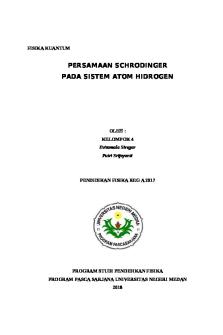8. LECT9 - Schrodinger WAVE EQN PDF

| Title | 8. LECT9 - Schrodinger WAVE EQN |
|---|---|
| Course | Introduction to Physical Chemistry |
| Institution | University of Surrey |
| Pages | 2 |
| File Size | 106.3 KB |
| File Type | |
| Total Downloads | 41 |
| Total Views | 131 |
Summary
Download 8. LECT9 - Schrodinger WAVE EQN PDF
Description
INTRO TO SCHRODINGER WAVE EQUATION Dynamic of microscopic systems
Quantum mechanical view: o A particle is spread through space like a wave
Wavefunction (Ψ) details the behaviour of an electron-wave
Probability of finding an e- at a given pt in space = ψ2
Schrodinger wave eqn (1927)
Double partial differential eqn
TOTAL ENERGY = KINETIC ENERGY + POTENTIAL ENERGY (V)
o ET= ½mv2 + V =
V= potential energy
v= velocity = distance travelled/time – ms-1
The eqn can be represented as: ΗΨ=ΕΨ o Where H= Hamiltonian operator; E= energy; Ψ= wavefunction
Hamiltonian operator:
Only used in particle-in-a-box
Simple form of the Schrodinger eqn:
o
If there is no potential energy free particle
If there is potential energy stored (eg. Spring) chemical bond
If potential energy stored in electric attraction b/t a +vely & -vely charged particle (Coulombic potential) H-atom
Ψ in 3 cases:
Ψ for freely moving particle = sin(x) [sin curve]
Ψ for particle free to oscillate near a pt = e-x^2 [bond vibrating]
Ψ for e- in H-atom = e-r [r=distance from the nucleus]
Physical significance of Ψ
Born interpretation: probability of finding a particle in a small region of space of volume δV = proportional to Ψ2δV o Where Ψ=wavefunction in the region
Ψ2 probability density o Probability = probability density * volume of region of interest o Low Ψ2 value = small chance of finding the particle...
Similar Free PDFs

8. LECT9 - Schrodinger WAVE EQN
- 2 Pages

CMSC421-lect9
- 63 Pages

Half wave Full Wave
- 4 Pages

Exam I eqn sheet
- 2 Pages

Teoría de Schrodinger
- 6 Pages

ME2002 Eqn Sheet
- 6 Pages

Schrodinger. Las paradojas cuanticas
- 125 Pages

The Third Wave-teacher
- 5 Pages

Sound Wave Lab report
- 2 Pages

Final-wave- Funda - fgfg
- 19 Pages

Wave Equation Derivation
- 2 Pages
Popular Institutions
- Tinajero National High School - Annex
- Politeknik Caltex Riau
- Yokohama City University
- SGT University
- University of Al-Qadisiyah
- Divine Word College of Vigan
- Techniek College Rotterdam
- Universidade de Santiago
- Universiti Teknologi MARA Cawangan Johor Kampus Pasir Gudang
- Poltekkes Kemenkes Yogyakarta
- Baguio City National High School
- Colegio san marcos
- preparatoria uno
- Centro de Bachillerato Tecnológico Industrial y de Servicios No. 107
- Dalian Maritime University
- Quang Trung Secondary School
- Colegio Tecnológico en Informática
- Corporación Regional de Educación Superior
- Grupo CEDVA
- Dar Al Uloom University
- Centro de Estudios Preuniversitarios de la Universidad Nacional de Ingeniería
- 上智大学
- Aakash International School, Nuna Majara
- San Felipe Neri Catholic School
- Kang Chiao International School - New Taipei City
- Misamis Occidental National High School
- Institución Educativa Escuela Normal Juan Ladrilleros
- Kolehiyo ng Pantukan
- Batanes State College
- Instituto Continental
- Sekolah Menengah Kejuruan Kesehatan Kaltara (Tarakan)
- Colegio de La Inmaculada Concepcion - Cebu




